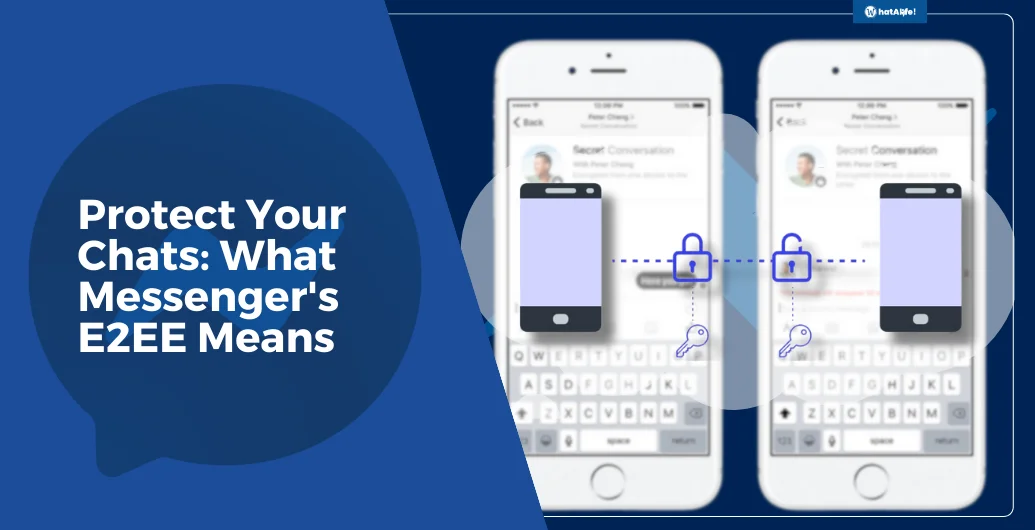In today’s digital world, privacy is a top concern. We share personal information and sensitive conversations online and ensuring their security is crucial. This is where Messenger’s end-to-end encryption (E2EE) comes in. Messenger is now taking a leap forward in privacy protection with the introduction of end-to-end encryption (E2EE) by default for all chats. You are now secured with an extra layer of protection. But what does end-to-end encrypted chat in Messenger actually mean and is this something you really need?
Table of Contents
What does E2EE in Messenger mean?
End-to-end encryption is a security measure that ensures the privacy of communication by encrypting the content in a way that only the sender and the intended recipient can decrypt and understand it. Even Meta is kept out of this secure zone – they cannot access the content of your encrypted messages.
How do I activate end-to-end encryption in Messenger?
While end-to-end encryption (E2EE) is already automatically enabled for all chats in the Messenger app, there are different scenarios depending on the platform you’re using:
On the Messenger App (Android and iOS):
No additional action is required from you. E2EE is already working in the background for all your existing and new chats.
On the Messenger Web Browser:
E2EE is not automatically enabled here. Here’s how to activate it for individual chats:
- Open a chat in the Messenger web browser.
- Click on the information icon (i) in the top right corner of the chat window.
- Select “Go to secret conversation.” This creates a new chat window specifically for this individual, with E2EE enabled. Your original chat remains unencrypted.
How to remove/deactivate/disable end-to-end encryption in Messenger?
To remove/deactivate/disable end-to-end encryption in Messenger for both Android and iOS devices, follow the steps below.
On the Messenger App (Android and iOS):
- Open the Messenger app.
- Tap three lines in the upper part, then tap settings.
- In the menu, tap Privacy & safety.
- Tap End-to-end encrypted chats.
- Tap Security alerts.
- Tap View logins.
- Tap on the name of the device you want to remove.
- Tap Log out.
Advantage of using E2EE
- Only you and the recipient can read your messages, even if someone intercepts them during transmission.
- E2EE makes accessing your conversations significantly harder for unauthorized individuals or hackers.
- Knowing your messages are shielded gives you greater confidence and trust when communicating online.
Also Read: Silent Strategies: Leaving a Group Chat Without Anyone Knowing on Messenger
Disadvantage of using E2EE
While E2E offers significant advantages in terms of privacy and security, there are also some drawbacks to consider. Due to the encryption, law enforcement agencies may be unable to access the content of messages even with a warrant, potentially hindering investigations into crimes like terrorism or child exploitation. This can spark debates about balancing security and public safety. While E2E protects private communication, individuals can also misuse it to engage in harmful activities like spreading misinformation or hate speech without being easily traced.
It’s important to weigh the benefits and drawbacks of E2E when deciding whether to use it for your communication needs. Consider the sensitivity of the information you’re sharing, the potential risks involved, and your personal level of comfort with technology
Things to Remember
- E2EE is currently enabled by default for all chats in the Messenger app. However, in the web browser version, you need to activate it manually for each conversation.
- While E2EE protects messages while in transit, it doesn’t safeguard them once delivered. The sender and recipient can still see them.
- Always exercise caution about the information you share online, even with E2EE enabled.
Frequently Asked Questions
What is end-to-end encryption (E2EE) on Messenger?
E2EE is a security feature that scrambles the content of your messages and calls before they leave your device and only the recipient’s device has the key to unscramble them. This means that even Meta (the company behind Messenger) cannot access the content of your communications.
Is E2EE enabled by default on Messenger?
Yes, E2EE is now automatically enabled for all chats in the Messenger app. However, in the web browser version, you need to activate it manually for each chat.
Does E2EE protect my messages from everyone?
While E2EE prevents unauthorized access during transmission, it’s important to remember:
- The sender and recipient can still see the messages after they are delivered.
- E2EE does not protect your messages from being saved on your own device or the recipient’s device.
- It’s essential to be mindful of the information you share online, even with E2EE enabled.
Are there any limitations to E2EE?
- E2EE is currently not available for group chats or calls with more than five participants.
- Features like message forwarding and disappearing messages are not available in E2EE chats.
Also Read: How to stop Facebook from chirping when you scroll
Who should use E2EE?
Anyone who wants an extra layer of privacy for their online communication can benefit from E2EE. It’s especially useful for sensitive conversations or when dealing with confidential information.
I have a different question about E2EE on Messenger. Where can I find more information?
You can visit the official Messenger Help Center for more information and troubleshooting assistance.
Key Takeaway
With the new security feature now the default for Messenger, you can have peace of mind knowing your conversations are shielded from prying eyes. Now that you know what is end-to-end encrypted chat in Messenger for and its disadvantages, it is always crucial to remember that while this extra layer of security is valuable, remaining cautious about the information you share online is crucial, even with E2EE enabled. For further details or assistance, visit the official Messenger Help Center.
Keep Reading: Silent Strategies: Android’s Long Press Version

Leave a Reply